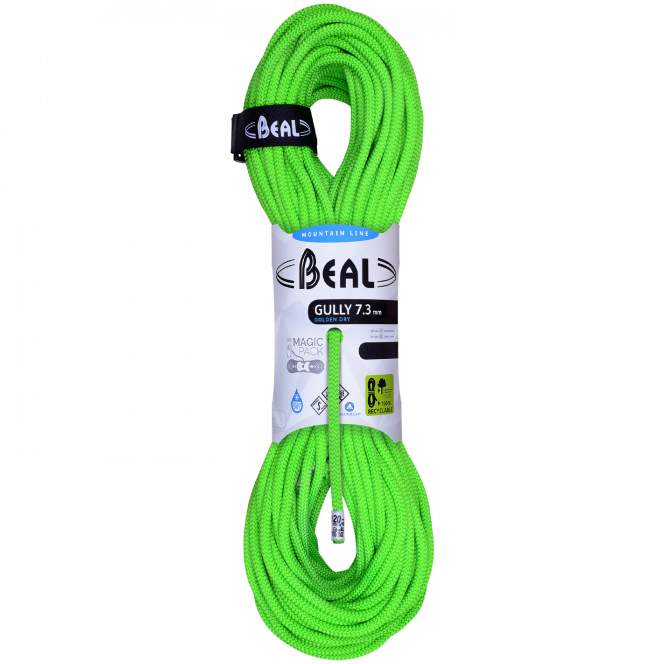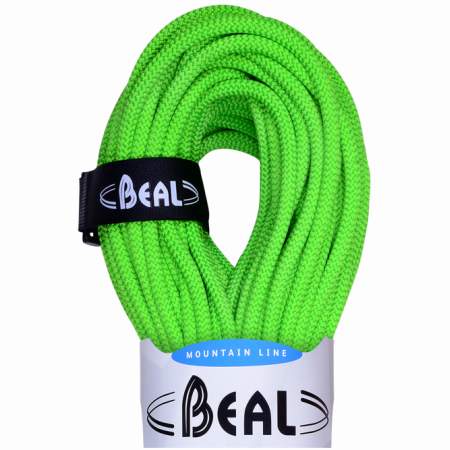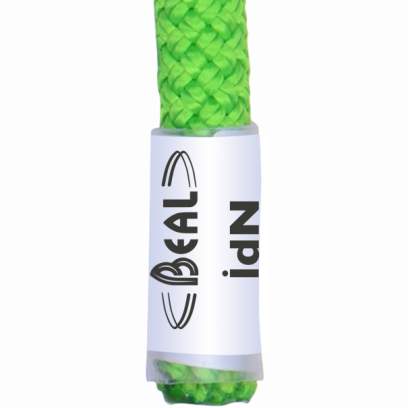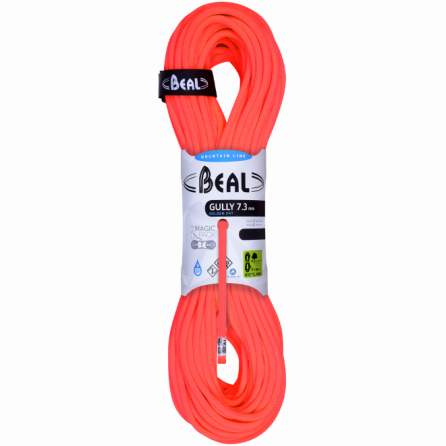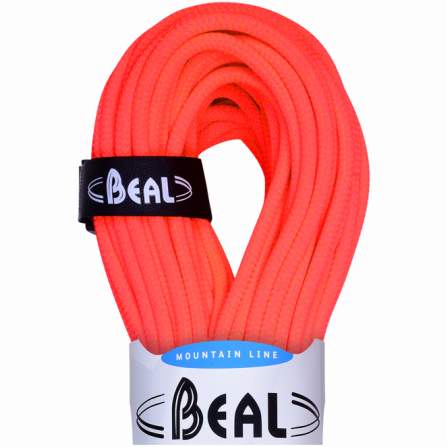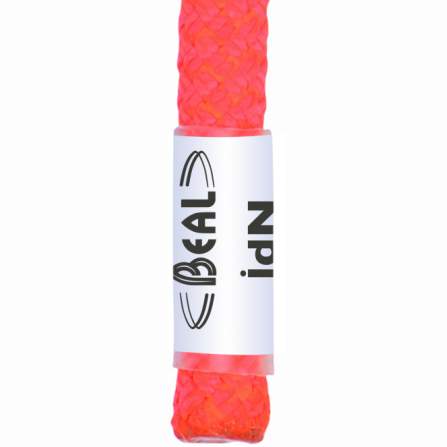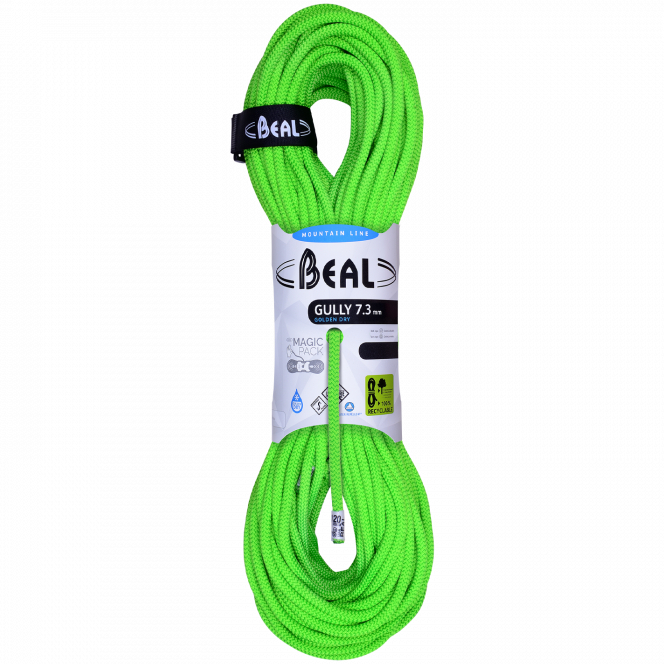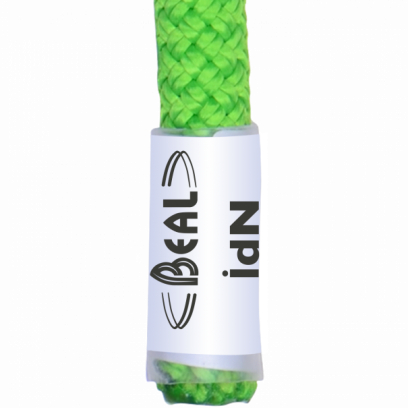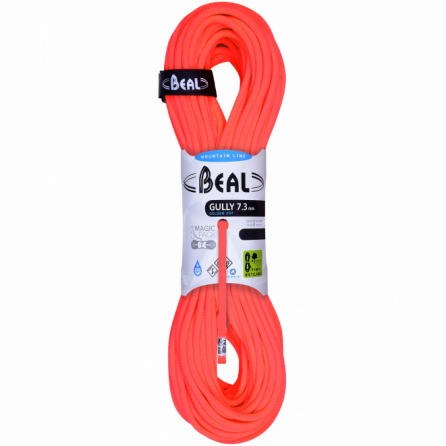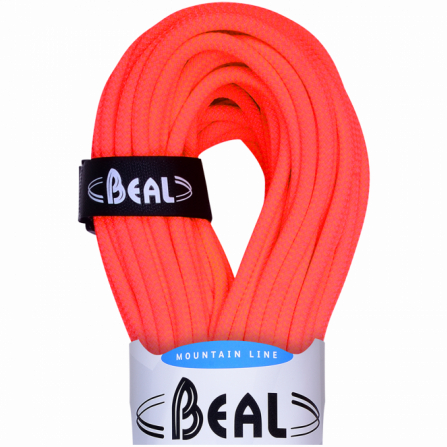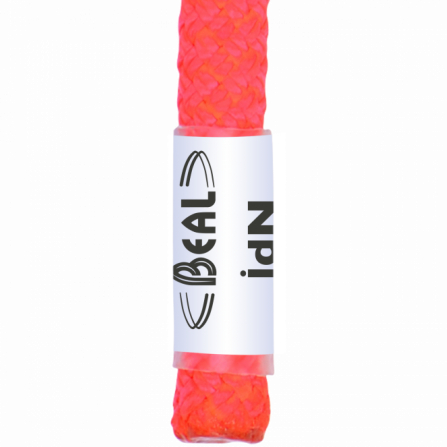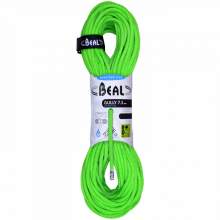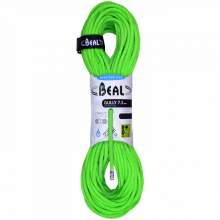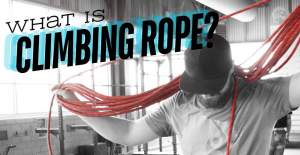How to use 7.3mm Gully correctly, precautions, lifetime, care and maintenance with instructional pictures.
7.3mm Gully Unicore 60m 2xDry
Description
Weighing only 36 g per metre, the GULLY 7.3 is the lightest double rope on the market. It is also certified as twin rope. Its extremely light weight and very low impact force make the GULLY 7.3 the ideal rope for ice climbing, mountaineering and the most demanding terrain. Like all other thin double ropes in BEAL's range, the GULLY 7.3 benefits from the reliability and additional safety that UNICORE technology provides.
Warning: Extreme care is required for both belaying and abseiling. The very thin diameter requires the use of compatible devices and limits its suitability to experts who are familiar with thin, slick ropes.
STRONG POINTS:
• Lightweight.
• Free-running.
• Golden Dry series.
• UNICORE technology benefits.
Retail price
This Product is Hard to Find.
We don’t know where you can buy this item online in the US. We’ll continue to check all the major retailers and will update this page as soon as we find one.
If you know where to find this online in the US, let us know, and we’ll add the link.


| Weight | 36.0 g/m 4.761 lbs / 2160 g |
| Diameter (millimeters) | 7.3 mm |
| Length (meters) | 60 m |
Rope Type  Type
There are 3 types of dynamic ropes that are used by climbers. They are known as Single, Half (Double), and Twin. The type of rope preferred varies by climbing style, location, and region. Single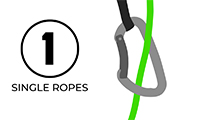
By far, the most common type of rope. Great for indoors and out. In the US, it is the most common sport and big wall and are also used for trad cragging. The handling is simple and the diameter options are quite varied. Half (Double)
The best cure for a meandering route, only one of the ropes will clip into each piece of protection so a mindful climber can can reduce rope drag considerably. You can also rappel twice the distance, it’s easier to safely protect traverse pitches and there is a smaller chance that both ropes would become damaged (by rockfall, crampons, etc). Twin
Both ropes must be clipped through each piece of protection. This is the lightest style of (two) ropes. They excel for rappels, going twice the distance vs a single rope, but do not have the ability to mitigate rope drag even though there are two ropes. It is unlikely both ropes will be damaged at once, and is why many alpine, ice and mixed climbers choose twin and/or half ropes. Learn More
Every rope type and when to use them | Half/Twin |
UIAA Falls (Single / Half / Twin)  UIAA FallsThis refers to the number of UIAA falls a rope has been tested to be able to withstand without breaking. The UIAA fall is a complicated test that is designed to create a uniform standard for strength in ropes, and is not generally reflective of real-world climbing situations. The test involves dropping a weight tied to the rope in such a way that it will see the highest amount of force a real-world situation could generate. The UIAA requires that Single and Half ropes must pass this test without breaking at least 5 times, while twin ropes must withstand 12 falls. In practice, it can likely be concluded that ropes that have higher than this standard number of falls will be stronger and put up with more abuse. It is important to note that any rope that is UIAA or EN certified is considered safe to climb on, regardless of the number of UIAA falls it is rated for. | 0 falls / 6 falls / 12 falls |
Dynamic Elongation (Single / Half / Twin)  Dynamic ElongationThis refers to the amount of stretch measured during the dynamic testing (or drop test) used when certifying ropes. Higher stretch will absorb more force and result in a softer catch but increases chances of groundfall at the beginning of a climb. The EN and UIAA require a stretch of at least 10% and no more than 40% for dynamic ropes. Single and Half ropes are tested individually and Twin ropes are tested as a pair. | 0.0 % / 35.0 % / 34.0 % |
Static Elongation (Single / Half / Twin)  Static ElongationThis refers to the amount of stretch measured during the static test used when certifying ropes. Most climbers will notice the difference in static elongation when climbing in a top rope situation, where higher stretch will make for a springier belay and could result in a ground fall when climbing closer to the ground. The EN and UIAA require a stretch of no more than 10% for Single and Twin ropes and no more than 12% for Half ropes. Single and Half ropes are tested individually and Twin ropes are tested as a pair. | 0.0 % / 10.1 % / 8.9 % |
Impact Force (Single / Half / Twin)  Impact ForceImpact force is the amount of force in kN that is measured at the testing mass during the UIAA dynamic drop rope test. When the weight is dropped, the force measured must be at or below 12kN for Single and Twin ropes and 8kN for Half ropes. The real world application of this test is determining that the rope can dissipate and absorb the appropriate amount of force from the fall as it would be felt by the climber. The variables used in the test set a situation that is well beyond anything climbers encounter, and shouldn't be considered realistic to actual climbing situations. In reality forces of this magnitude would result in severe injury as this test is designed to test the limits of the rope and not the comfort of the climber. | 0.00 kN / 5.20 kN / 8.00 kN |
Dry Treatment  Dry TreatmentWhen a rope is dry treated, it has had a coating applied to its core fibers, its sheath fibers, or both. The purpose of this coating is to reduce the amount of water the rope can absorb when in wet or icy conditions. Wet ropes are heavier, handle and belay differently, and have been tested to be weaker than dry ropes. Many climbers prefer dry treated ropes for very dusty or dirty environments, as they are more resistant to uptake of dirt and can stay cleaner longer. Learn More
Benefits of Dry vs Non-Dry ropes | Sheath & Core UIAA Certified Dry (aka Golden Dry) |
| Sheath Proportion (%) | 45.0 % |
| Sheath Slippage (mm) | 0 mm |
| Type of Middle Mark | None |
| Rope End Marker | None |
| Certification | CE, EN, UIAA |
RFID / NFC Option  RFID and NCFThis technology can be helpful if you are a gym or professional business where you'd like to track the usage and age of your ropes. RFID is how items are uniquely identified using radio waves (Radio Frequency Identification). It's for 1-way communication from 10cm to 100m away depending on the frequency. Example: Airport Baggage. NFC is a subset of RFID that is restrained to close proximity communication typically less than 10cm (Near Field Communication). NFC chips can operate a 2-way signal to exchange information. Example: Apple Pay. | None |
No reviews yet.
After many pitches of climbing, the ropes showed little wear. The Dry Cover treatment works! In the late fall, I took them out on a sandstone route that was partially covered in snow and ice. After being exposed to wet sand and melting snow, these ropes were still clean and dry at the end of the day.
Overall, I am digging these ropes and can’t wait to get them out next season for some long summer days on the rock!
Light is right in the high country, and the Gully 7.3mm half ropes have the lowest weight of any other rope on the market at 36 g/m. Yep, that’s right, less than 5 pounds for 60 meters. Since it’s rated as a twin rope as well, testers took it on ice in New Hampshire and wandery routes in Eldorado Canyon, Colorado, and loved the stiff and durable feel. “Even though it’s the thinnest rope I’ve ever climbed on, it still felt substantial in my hands and running through the belay device,” one tester said of the tight sheath weave and Golden Dry treatment. Plus, the Unicore technology gave users extra peace of mind in sketchy terrain. Unicore is a thin filament between the sheath and the core that bonds the two together so if the rope gets chopped, the sheath won’t slide down and expose more of the strength-giving core. The Gully’s Golden Dry treatment, Beal’s proprietary
process, repelled water from drippy ice and when left in the snow during belays.
Details about Beal Gully rope.

